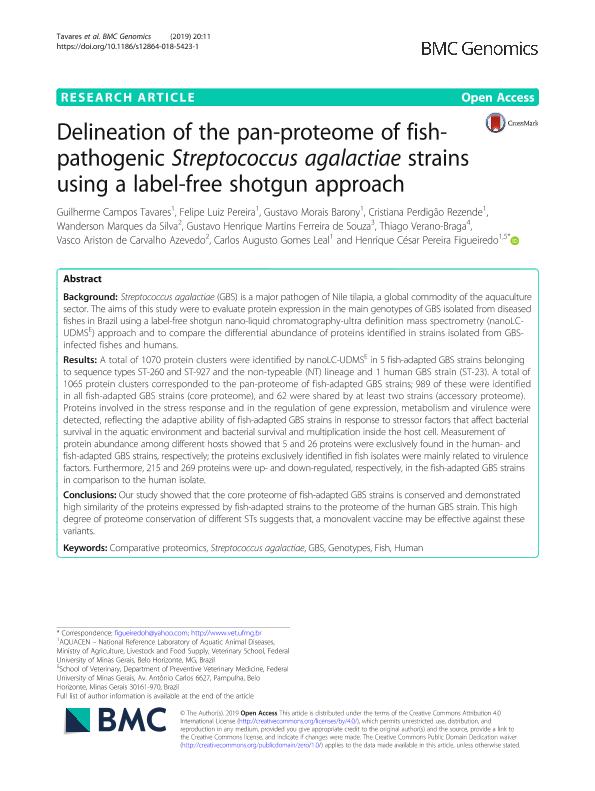Artículo
Delineation of the pan-proteome of fish-pathogenic Streptococcus agalactiae strains using a label-free shotgun approach
Tavares Campos, Guilherme; Pereira, Felipe Luiz; Morais Barony, Gustavo; Perdigão Rezende, Cristiana; Marques Da Silva, Wanderson ; Martins Ferreira de Souza, Gustavo Henrique; Verano Braga, Thiago; De Carvalho Azevedo, Vasco Ariston; Gomes Leal, Carlos Augusto; Pereira Figueiredo, Henrique César
; Martins Ferreira de Souza, Gustavo Henrique; Verano Braga, Thiago; De Carvalho Azevedo, Vasco Ariston; Gomes Leal, Carlos Augusto; Pereira Figueiredo, Henrique César
 ; Martins Ferreira de Souza, Gustavo Henrique; Verano Braga, Thiago; De Carvalho Azevedo, Vasco Ariston; Gomes Leal, Carlos Augusto; Pereira Figueiredo, Henrique César
; Martins Ferreira de Souza, Gustavo Henrique; Verano Braga, Thiago; De Carvalho Azevedo, Vasco Ariston; Gomes Leal, Carlos Augusto; Pereira Figueiredo, Henrique César
Fecha de publicación:
07/01/2019
Editorial:
BioMed Central
Revista:
BMC Genomics
ISSN:
1471-2164
Idioma:
Inglés
Tipo de recurso:
Artículo publicado
Clasificación temática:
Resumen
Background: Streptococcus agalactiae (GBS) is a major pathogen of Nile tilapia, a global commodity of the aquaculture sector. The aims of this study were to evaluate protein expression in the main genotypes of GBS isolated from diseased fishes in Brazil using a label-free shotgun nano-liquid chromatography-ultra definition mass spectrometry (nanoLC-UDMS E ) approach and to compare the differential abundance of proteins identified in strains isolated from GBS-infected fishes and humans. Results: A total of 1070 protein clusters were identified by nanoLC-UDMS E in 5 fish-adapted GBS strains belonging to sequence types ST-260 and ST-927 and the non-typeable (NT) lineage and 1 human GBS strain (ST-23). A total of 1065 protein clusters corresponded to the pan-proteome of fish-adapted GBS strains; 989 of these were identified in all fish-adapted GBS strains (core proteome), and 62 were shared by at least two strains (accessory proteome). Proteins involved in the stress response and in the regulation of gene expression, metabolism and virulence were detected, reflecting the adaptive ability of fish-adapted GBS strains in response to stressor factors that affect bacterial survival in the aquatic environment and bacterial survival and multiplication inside the host cell. Measurement of protein abundance among different hosts showed that 5 and 26 proteins were exclusively found in the human- and fish-adapted GBS strains, respectively; the proteins exclusively identified in fish isolates were mainly related to virulence factors. Furthermore, 215 and 269 proteins were up- and down-regulated, respectively, in the fish-adapted GBS strains in comparison to the human isolate. Conclusions: Our study showed that the core proteome of fish-adapted GBS strains is conserved and demonstrated high similarity of the proteins expressed by fish-adapted strains to the proteome of the human GBS strain. This high degree of proteome conservation of different STs suggests that, a monovalent vaccine may be effective against these variants.
Palabras clave:
COMPARATIVE PROTEOMICS
,
FISH
,
GBS
,
GENOTYPES
,
HUMAN
,
STREPTOCOCCUS AGALACTIAE
Archivos asociados
Licencia
Identificadores
Colecciones
Articulos (IABIMO)
Articulos de INSTITUTO DE AGROBIOTECNOLOGIA Y BIOLOGIA MOLECULAR
Articulos de INSTITUTO DE AGROBIOTECNOLOGIA Y BIOLOGIA MOLECULAR
Citación
Tavares Campos, Guilherme; Pereira, Felipe Luiz; Morais Barony, Gustavo; Perdigão Rezende, Cristiana; Marques Da Silva, Wanderson; et al.; Delineation of the pan-proteome of fish-pathogenic Streptococcus agalactiae strains using a label-free shotgun approach; BioMed Central; BMC Genomics; 20; 1; 7-1-2019; 1-22
Compartir
Altmétricas



